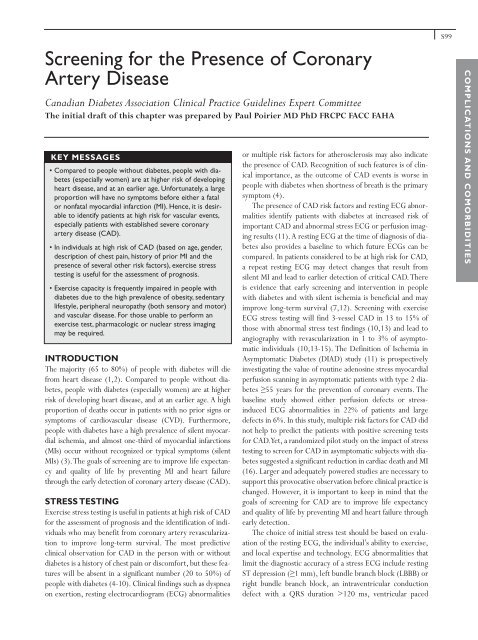2008 Clinical Practice Guidelines - Canadian Diabetes Association
2008 Clinical Practice Guidelines - Canadian Diabetes Association
2008 Clinical Practice Guidelines - Canadian Diabetes Association
Create successful ePaper yourself
Turn your PDF publications into a flip-book with our unique Google optimized e-Paper software.
Screening for the Presence of Coronary<br />
Artery Disease<br />
<strong>Canadian</strong> <strong>Diabetes</strong> <strong>Association</strong> <strong>Clinical</strong> <strong>Practice</strong> <strong>Guidelines</strong> Expert Committee<br />
The initial draft of this chapter was prepared by Paul Poirier MD PhD FRCPC FACC FAHA<br />
KEY MESSAGES<br />
• Compared to people without diabetes, people with diabetes<br />
(especially women) are at higher risk of developing<br />
heart disease, and at an earlier age. Unfortunately, a large<br />
proportion will have no symptoms before either a fatal<br />
or nonfatal myocardial infarction (MI). Hence, it is desirable<br />
to identify patients at high risk for vascular events,<br />
especially patients with established severe coronary<br />
artery disease (CAD).<br />
• In individuals at high risk of CAD (based on age, gender,<br />
description of chest pain, history of prior MI and the<br />
presence of several other risk factors), exercise stress<br />
testing is useful for the assessment of prognosis.<br />
• Exercise capacity is frequently impaired in people with<br />
diabetes due to the high prevalence of obesity, sedentary<br />
lifestyle, peripheral neuropathy (both sensory and motor)<br />
and vascular disease. For those unable to perform an<br />
exercise test, pharmacologic or nuclear stress imaging<br />
may be required.<br />
INTRODUCTION<br />
The majority (65 to 80%) of people with diabetes will die<br />
from heart disease (1,2). Compared to people without diabetes,<br />
people with diabetes (especially women) are at higher<br />
risk of developing heart disease, and at an earlier age. A high<br />
proportion of deaths occur in patients with no prior signs or<br />
symptoms of cardiovascular disease (CVD). Furthermore,<br />
people with diabetes have a high prevalence of silent myocardial<br />
ischemia, and almost one-third of myocardial infarctions<br />
(MIs) occur without recognized or typical symptoms (silent<br />
MIs) (3).The goals of screening are to improve life expectancy<br />
and quality of life by preventing MI and heart failure<br />
through the early detection of coronary artery disease (CAD).<br />
STRESS TESTING<br />
Exercise stress testing is useful in patients at high risk of CAD<br />
for the assessment of prognosis and the identification of individuals<br />
who may benefit from coronary artery revascularization<br />
to improve long-term survival. The most predictive<br />
clinical observation for CAD in the person with or without<br />
diabetes is a history of chest pain or discomfort, but these features<br />
will be absent in a significant number (20 to 50%) of<br />
people with diabetes (4-10). <strong>Clinical</strong> findings such as dyspnea<br />
on exertion, resting electrocardiogram (ECG) abnormalities<br />
or multiple risk factors for atherosclerosis may also indicate<br />
the presence of CAD. Recognition of such features is of clinical<br />
importance, as the outcome of CAD events is worse in<br />
people with diabetes when shortness of breath is the primary<br />
symptom (4).<br />
The presence of CAD risk factors and resting ECG abnormalities<br />
identify patients with diabetes at increased risk of<br />
important CAD and abnormal stress ECG or perfusion imaging<br />
results (11).A resting ECG at the time of diagnosis of diabetes<br />
also provides a baseline to which future ECGs can be<br />
compared. In patients considered to be at high risk for CAD,<br />
a repeat resting ECG may detect changes that result from<br />
silent MI and lead to earlier detection of critical CAD.There<br />
is evidence that early screening and intervention in people<br />
with diabetes and with silent ischemia is beneficial and may<br />
improve long-term survival (7,12). Screening with exercise<br />
ECG stress testing will find 3-vessel CAD in 13 to 15% of<br />
those with abnormal stress test findings (10,13) and lead to<br />
angiography with revascularization in 1 to 3% of asymptomatic<br />
individuals (10,13-15). The Definition of Ischemia in<br />
Asymptomatic <strong>Diabetes</strong> (DIAD) study (11) is prospectively<br />
investigating the value of routine adenosine stress myocardial<br />
perfusion scanning in asymptomatic patients with type 2 diabetes<br />
≥55 years for the prevention of coronary events. The<br />
baseline study showed either perfusion defects or stressinduced<br />
ECG abnormalities in 22% of patients and large<br />
defects in 6%. In this study, multiple risk factors for CAD did<br />
not help to predict the patients with positive screening tests<br />
for CAD.Yet, a randomized pilot study on the impact of stress<br />
testing to screen for CAD in asymptomatic subjects with diabetes<br />
suggested a significant reduction in cardiac death and MI<br />
(16). Larger and adequately powered studies are necessary to<br />
support this provocative observation before clinical practice is<br />
changed. However, it is important to keep in mind that the<br />
goals of screening for CAD are to improve life expectancy<br />
and quality of life by preventing MI and heart failure through<br />
early detection.<br />
The choice of initial stress test should be based on evaluation<br />
of the resting ECG, the individual’s ability to exercise,<br />
and local expertise and technology. ECG abnormalities that<br />
limit the diagnostic accuracy of a stress ECG include resting<br />
ST depression (≥1 mm), left bundle branch block (LBBB) or<br />
right bundle branch block, an intraventricular conduction<br />
defect with a QRS duration >120 ms, ventricular paced<br />
S99<br />
COMPLICATIONS AND COMORBIDITIES











